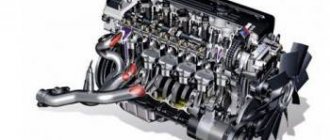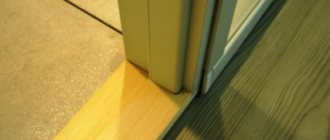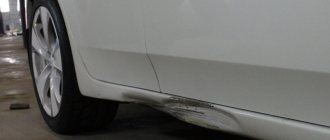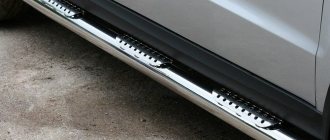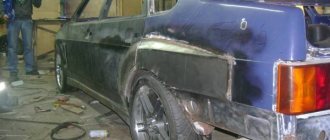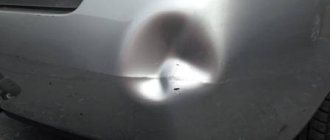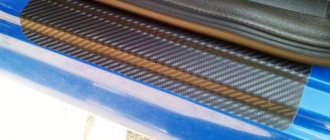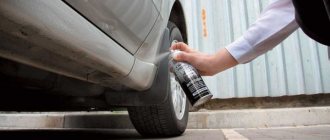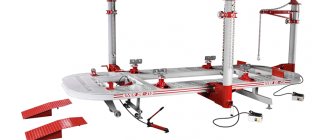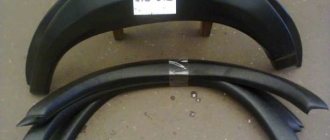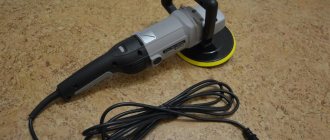Driving through deep asphalt holes sometimes ends in disaster for motorists. A car with a long wheelbase sometimes falls through and touches the hard asphalt side with the edge of the body. It turns out to be a dent. In addition, on broken spring roads, asphalt debris sometimes jumps out from under the wheels, rises up and rams the lower part of the car body. Together with the dent, severe damage to the paintwork is formed, which threatens the formation of rust spots. Do dented sills affect the handling of the car and do they need to be repaired immediately after an impact?
What are the defects?
According to the nature of their origin, all defects are classified as natural, mechanical. In the first category:
Mechanical damage means:
The repair procedure is selected depending on the degree of damage; if corrosion has covered more than 70%, the part is completely replaced. In case of deformation, if the metal does not require cutting, it is enough to straighten it. If the outer layer of anti-corrosion is damaged without damaging the outer and inner parts of the metal, then clean it and apply protection.
Typically, drivers have to repair a part after hitting an obstacle; you can straighten the threshold on a car with your own hands if there is no internal wear of the metal.
Changing the pillar and threshold
If the threshold and the pillar are damaged, then it is necessary to replace the threshold and the pillar at the same time. You need to follow a simple procedure.
First, the B-pillar spar must be cut out. Before straightening the spar, you need to make sure that the car body is strong.
After this, the installation site must be cleaned, and all excess metal must be removed.
Next, the surface of the spar must be leveled and adjusted. After this, fastening, installation and welding are carried out. That's all. All that remains is to put the doors in place and adjust the gaps.
Types of car thresholds
Car thresholds can be fixed or removable. The first relate to the power parts of the body; they form a single structure with the bottom, providing the base with the established rigidity. All VAZ and BMW models until 2010, Opel brands, and some cars of Japanese and Korean brands were equipped with non-removable ones.
The removable element is installed from the passenger compartment and is bolted to the bottom base. The part can be easily removed and repaired if a dent appears, the paintwork is chipped, or the first pockets of corrosion are noticeable. Removable thresholds can be easily replaced with original replicas, so in case of serious damage or cracks, the part cannot be repaired.
The straightening of a non-removable threshold is carried out by welding, drawing, straightening, and of removable ones only by straightening.
Repair of fixed parts
Structurally, the non-removable thresholds are a hollow box, the main element of which remains the amplifier, as the power part of the bottom. The external element serves to protect the body and as a decor that improves the appearance of the car.
When repairing, the car is placed on a jack or lift for the convenience of the technician. If it is necessary to cut out part of a part or use welding, then the doors and floor covering are removed. For small dents, you can pull out the threshold without painting using a reverse hammer or staples. The most common garage repairs of non-removable elements:
To perform repairs you will need a set of tools, equipment and the necessary skills. The complexity of the work lies in the fact that the part cannot be dismantled; if welding is carried out, it must be done directly on the car.
Repair of removable parts
This does not require much experience; it is enough to be able to straighten metal with a hammer. If drawing is carried out, the removable part can be easily secured on the machine. Correction and filling of holes on removable thresholds is carried out much less frequently than on welded ones; when plastic linings become deformed, in 90% of cases they are simply replaced with new ones. The price of new parts will not exceed the cost of services at a service station.
How to repair it yourself without painting
Among all types of repairs, pulling out the threshold without painting is possible only in the case of slight deformation, without a sharp edge, when the paintwork is not damaged. A smooth dent without folds can be pulled out on its own in only two ways:
At service stations, a type of paintless body service using PDR technology is common. In this way, small, shallow deformations are eliminated. Craftsmen use special tools: levers and hammers, squeezing out a dent always occurs from the inside. When repairing a non-removable body element, it is necessary to use external tools; vacuum suction cups remain the best option. Considering that most defects are associated with damage to paintwork and metal cracks, the paintless method is not used when:
In case of such damage, it is necessary to carry out full surface treatment before and after reducing the dent.
How to pull out a threshold with a reverse hammer
Pulling out a threshold with a reverse hammer is considered one of the most popular and easiest ways to remove significant dents from a non-removable element. For repair you will need:
Before work, you must remove the negative terminal from the battery and hang the car on a jack. We will look at how to straighten the threshold on a car with our own hands step by step:
You cannot start drawing immediately after welding the hammer; you must wait until the part has cooled.
Using a reverse hammer remains the most reliable way to repair permanent thresholds when deformed. It is guaranteed to be free from internal welding corrosion and is available at home.
Suction cup pulling
The use of a suction cup or vacuum hammer is justified in cases where the dent is small and repairs can be limited to without painting. However, if there is old damage, a complete surface treatment is carried out after extraction.
Drivers turn to the service station with one question: what to do if the threshold on the car is bent? Without understanding the nuances of the damage, they, as a rule, pay 70% more for the work of a tinsmith. To prevent this from happening, you need to remember: if the dent is corrected with a suction cup without additional painting, the technician spends up to 15 minutes on maintenance, and the cost of the work is calculated from time to time.
The steps are similar to using a reverse hammer, but the vacuum pump plays the role of a puller. The difficulty of using the device is due to the fact that, due to the unevenness of the deformation, it is not always possible to install the pump on the part. Repair process step by step:
Can a CASCO policy work without calling the traffic police? All the nuances of “full” car insurance
Before this incident, I had not encountered any problems with their registration. The bank representative filled out the documents from dictation. After payment, the documents were sent to my email. The bank called and we made an appointment to inspect the car. During the inspection and signing of the documents, an error was discovered: the vehicle’s license plate number was incorrect. The employee called the bank and reported this, I signed the documents. The employee called the bank and reported this, I signed the documents with the correct information. In the evening I received documents by mail, but with the same error.
How to repair a bent car sill
Car sills are body elements that are subject to constant and maximum mechanical, vibration and temperature loads, and suffer from high humidity and corrosion. Awkward parking or a minor accident - and the threshold turns out to be jammed, which violates the geometry of the body and the external aesthetics of the car, interferes with the closing of the car doors and creates a threat of rapid corrosion of metal elements.
Therefore, repairing wrinkled thresholds is a common situation at service stations. How do car service professionals repair jammed door sills? Is it possible to level the threshold on a car yourself? How to do this, and what tool is needed for this?
Repair of thresholds at service stations
A bent or jammed threshold cannot be left for a long time without repair, in order to prevent, at a minimum, the growth of corrosion (if the threshold is injured, the paintwork is usually damaged as well). In this case, it is better to entrust repairs to car service technicians - they have the necessary equipment, anti-corrosion materials and paintwork materials.
The price of repairs at different service stations varies significantly and depends on the type of part, the type and degree of damage, and the need for welding work. The minimum price for fixing a dent, for example, is 500-1200 rubles, and a complete repair of a threshold with anti-corrosion treatment and paint restoration - from 5000 rubles.
The need to contact a car service specialist depends on the degree of damage to the thresholds. If it is a small dent, you can deal with it yourself, but it will be difficult for you to restore it yourself if the threshold:
In these cases, the part requires not just drawing, but also straightening and straightening with dismantling, and in especially difficult cases, complete replacement. And sometimes together with the stand.
Factors affecting cost
Every motorist who needs to level the thresholds in their car is looking for a company that provides a similar service at an affordable price. For this purpose, the car owner calls a number of companies and clarifies the cost and terms of cooperation. The price varies significantly among different organizations. This is due to the impact on the cost of the following factors:
- Depth of the dent.
- Number of defects.
- Difficulty of work.
- Devices and tools used.
- The need to paint a car.
- Type of straightening.
- Material for manufacturing the spare part.
- Car model.
- Urgency of work.
- Prestige of the company.
Methods for repairing thresholds at service stations
The technology for repairing a jammed threshold depends both on the degree of damage and on the type of part itself: thresholds can be removable or non-removable.
Repair of a removable threshold in a car service
Removable sills are attached to the body with self-tapping screws. Therefore, their repair is simpler and cheaper - they can simply be twisted, after which they can be easily pulled out and straightened with a mallet on a workbench, covered with new paint and an anti-corrosion compound. If the part is severely distorted, has through holes and is covered with a large layer of rust, it is easier to simply replace it with a new threshold.
Repair of a fixed threshold at a service station
Fixed sills are welded to the base of the car body, so their repair is more difficult and more expensive. If the part has minor dents and the paintwork is not damaged, dismantling the threshold will not be necessary - it can be pulled out and leveled using:
In the latter two cases, the holes are then carefully welded using a tin solder welder. If the part is severely damaged, it is easier to cut it out partially or entirely, and a new threshold is welded in its place. The seams are sanded, smoothed, degreased and painted over.
The threshold of the car is jammed: the cost of repair, what to do and how to fix it yourself
Car sills are body elements that are subject to constant and maximum mechanical, vibration and temperature loads, and suffer from high humidity and corrosion. Awkward parking or a minor accident - and the threshold turns out to be jammed, which violates the geometry of the body and the external aesthetics of the car, interferes with the closing of the car doors and creates a threat of rapid corrosion of metal elements.
Therefore, repairing wrinkled thresholds is a common situation at service stations. How do car service professionals repair jammed door sills? Is it possible to level the threshold on a car yourself? How to do this, and what tool is needed for this?
Repair of thresholds at service stations
A bent or jammed threshold cannot be left for a long time without repair, in order to prevent, at a minimum, the growth of corrosion (if the threshold is injured, the paintwork is usually damaged as well). In this case, it is better to entrust repairs to car service technicians - they have the necessary equipment, anti-corrosion materials and paintwork materials.
The price of repairs at different service stations varies significantly and depends on the type of part, the type and degree of damage, and the need for welding work. The minimum price for fixing a dent, for example, is 500-1200 rubles, and a complete repair of a threshold with anti-corrosion treatment and paint restoration - from 5000 rubles.
The need to contact a car service specialist depends on the degree of damage to the thresholds. If it is a small dent, you can deal with it yourself, but it will be difficult for you to restore it yourself if the threshold:
- severely distorted by mechanical impact during an accident;
- deformed by a jack;
- damaged and has damaged paintwork;
- deformed and corroded.
In these cases, the part requires not just drawing, but also straightening and straightening with dismantling, and in especially difficult cases, complete replacement. And sometimes together with the stand.
Methods for repairing thresholds at service stations
The technology for repairing a jammed threshold depends both on the degree of damage and on the type of part itself: thresholds can be removable or non-removable.
Repair of a removable threshold in a car service
Removable sills are attached to the body with self-tapping screws. Therefore, their repair is simpler and cheaper - they can simply be twisted, after which they can be easily pulled out and straightened with a mallet on a workbench, covered with new paint and an anti-corrosion compound. If the part is severely distorted, has through holes and is covered with a large layer of rust, it is easier to simply replace it with a new threshold.
Repair of a fixed threshold at a service station
Fixed sills are welded to the base of the car body, so their repair is more difficult and more expensive. If the part has minor dents and the paintwork is not damaged, dismantling the threshold will not be necessary - it can be pulled out and leveled using:
- a special pneumatic suction cup, which is applied to the dent from the outside;
- vacuum inverter - a small hole is drilled into which air is pumped under pressure;
- reverse hammer - a small rectangular hole is made into which a small anvil is inserted, or transverse cuts are made for straightening.
In the latter two cases, the holes are then carefully welded using a tin solder welder. If the part is severely damaged, it is easier to cut it out partially or entirely, and a new threshold is welded in its place. The seams are sanded, smoothed, degreased and painted over.
Restoring car thresholds with your own hands
If you have the necessary tools, some experience and dexterity, you can repair a jammed threshold yourself, although an assistant is still needed.
With minor damage and preserved paintwork, it is not difficult to repair them. You will need a flat work surface (workbench), a set of straightening tools (hammers, mallets, chisels, planes).
The procedure for leveling a jammed threshold without restoring paintwork is performed sequentially:
- remove the threshold from the body (unscrew the screws);
- fix the threshold on the workbench;
- level the part using straightening hammers and mallets;
- treat the threshold surfaces with anti-corrosion protection;
- mount the threshold into the mounting locations on the body.
If the paintwork is damaged, you will need to clean and degrease the part, and then apply a layer of paint to the surface. If the threshold is severely damaged, you will additionally need a grinder, which can be used to cut out the damaged section of the part, and a welding machine to weld on a new section of the part. If the damage to the threshold is very serious, simply replace the part.
Restoring car thresholds with your own hands
If you have the necessary tools, some experience and dexterity, you can repair a jammed threshold yourself, although an assistant is still needed.
Fixed thresholds
With minor damage and preserved paintwork, it is not difficult to repair them. You will need a flat work surface (workbench), a set of straightening tools (hammers, mallets, chisels, planes).
The procedure for leveling a jammed threshold without restoring paintwork is performed sequentially:
If the paintwork is damaged, you will need to clean and degrease the part, and then apply a layer of paint to the surface. If the threshold is severely damaged, you will additionally need a grinder, which can be used to cut out the damaged section of the part, and a welding machine to weld on a new section of the part. If the damage to the threshold is very serious, simply replace the part.
Removable thresholds
Since it is impossible to dismantle the threshold, you will have to use other repair methods and additional tools - a spotter, winch, metal rod, grinder and welding machine. There are several options for leveling the threshold:
If the area of damage/deformation of the threshold is maximum, then it is easier to cut it off with a grinder and weld on a new threshold. The welding areas must be cleaned and smoothed, after which the part is degreased and coated with paint and an anti-corrosion compound.
Important! The above methods apply only to the repair of steel car thresholds. Plastic analogues are not repaired, but replaced when damaged.
In conclusion, it should be noted that a sill jam in the event of an accident, an accidental impact with a curb, or deformation with a jack is unpleasant, but not critical. Of course, such damage cannot be ignored, since damaged paintwork leads to increased body corrosion, but the repair itself is not a serious problem.
Depending on the type of car threshold and the degree of damage, you can restore it yourself, using several methods of drawing and straightening, as well as high-quality tools, or replace the damaged part completely. If you don’t have the time, experience, and the necessary equipment, just contact a service station, where such repairs will be performed for you quickly and inexpensively.
Varieties
Straightening can be of two types:
- With the removal of spare parts.
- No removal.
The first option is more expensive.
Depending on the painting, the service may be:
- With paint coating.
- No application.
According to the method of correcting the defect, the hood is:
- No welding.
- By welding.
Depending on who does the work, the service is:
- Professional (company specialist).
- Independent.
Depending on the location of the service, repair of auto parts can be:
- In the garage of a private master.
- At a car service.
- At the address where the car is located.
Traction is also classified depending on the size of the defect into the following types:
- Removing dents up to 3 cm.
- 5-8 cm.
- 10-15 cm.
- 20-30 cm.
- Over 30 cm.
According to the time allocated for work, the order can be:
- Urgent.
- Not urgent.
How to remove a dent on a car doorstep
Among all car components, sills are, of course, one of the most susceptible to all kinds of damage. Considering the state of modern Russian roads, dents on car sills, unfortunately, are a fairly common occurrence.
Very often, even minor damage to the car threshold disrupts the structure of its coating and contributes to the rapid spread of rust. Therefore, if the threshold of your vehicle is damaged, pulling or leveling must be done as quickly as possible.
Many motorists believe that this kind of work can only be done in a specialized workshop, but this is not true - almost anyone can pull out a dent on the threshold of a car.
Removing a dent on the threshold
What won't they pay for under CASCO?
The total amount of payments in the market decreased, but the average insurance payment per client increased. What things are important to know about a comprehensive insurance policy if you need to buy one? Casco only protects your car, including if the accident was your fault.
Damage is usually compensated up to a specified amount. CASCO insurance will not help in case of intentional damage or theft, if the car was driven by a person who does not have a driver’s license, if the driver was drunk, or if the insured event occurred outside the scope of the policy, for example, in another country.
The policy can be full or truncated. Truncated programs cover a limited set of insurance events. The situation largely depends on the theftability of a particular model. Casco is not an abbreviation. It is an international term meaning transport insurance.
By the way, the term comprehensive insurance applies not only to car insurance. You can buy comprehensive insurance for any other vehicles - ships, airplanes.
Leveling out dents on a removable threshold
Repairing damage to a removable threshold is much easier. For this type of work you will need:
To level out a dent on a car's removable threshold, proceed as follows:
It’s worth remembering that this method of pulling out dents on a car’s removable threshold is not universal. It is relevant only in cases where the threshold is not too damaged and can be returned to its original state with hammer blows.
However, if the dent cannot be repaired, or if rust has already affected it, it is better to throw away such a part and put another one in its place. The advantage of this method of leveling dents is that there is no need to paint the damaged fragment - it will retain its original color.
Leveling out dents on a cast threshold
It is usually much more difficult to pull out a dent on a cast car sill than on a removable one. You will need more time and tools, but this work is quite doable at home. The method used to remove a dent usually depends on its size and complexity. The most popular methods are :
The principle of operation of this unit is extremely simple: a suction cup is applied to the problem area of the threshold surface, all the air is pumped out of it, providing a reliable and soft grip.
After this, the unit is pulled out along with the surface of the threshold. These devices can be of different types, but their operating principle is always the same.
If the damage to the cast part is too severe and cannot be repaired by any of the methods described above, then the only thing you can do is cut it out entirely. To do this, it is necessary to dismantle the vehicle doors and floor coverings. After this, you have two options for solving the problem: straighten all the defects using straightening on a workbench, as is done with removable thresholds, or throw away the damaged part and weld a new one in its place.
Whatever method of removing dents on cast car parts you choose, you should never forget about anti-corrosion surface treatment. Thresholds are a very sensitive part and therefore extremely vulnerable to rust.
If you install a new threshold without protecting it from corrosion, most likely you will have to change it again in the near future - moisture will quickly penetrate into all the smallest defects on the surface and trigger the formation of rust.
If we are talking about repainting the threshold of a car, then you need to try to choose a color shade so that it matches the old paint as closely as possible. The same goes for varnish.
Source
